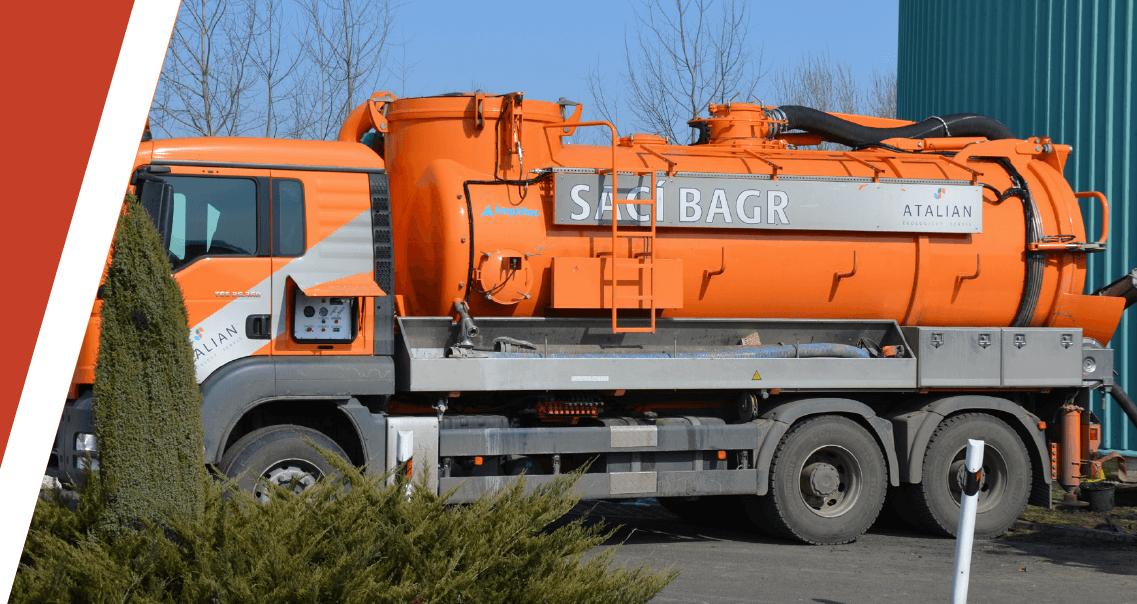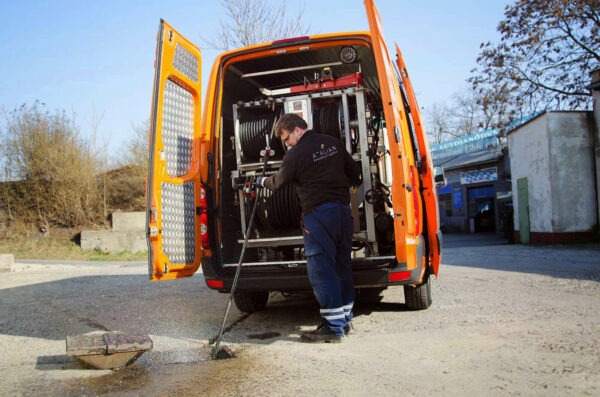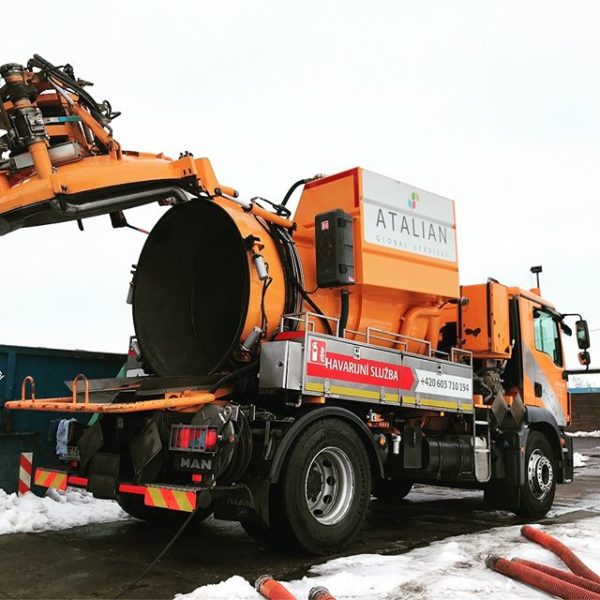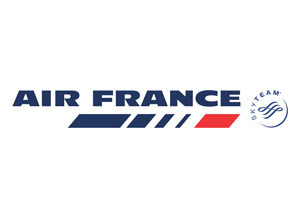The term suction excavator is an unusual phrase. The name ‘suction excavator’ first came to the Czech Republic in the nineties. It is a deliberate combination of the two fundamental characteristics of this special machine – it sucks (and very well) – hence SUCTION and it sucks up materials which normal tanker trucks can’t – hence EXCAVATOR.
A fundamental difference between suction vehicles with vacuum systems and a suction excavator is the suction source, their performance and suction pump’s technological protection. While suction vehicles are only intended for wet material suction and only suck under pressure, suction excavators suck both wet and dry materials, while in the most extreme applications they use the pneumatic suction effect – JUST LIKE A VACUUM CLEANER AT HOME – but with a slightly higher performance – 9000 m3 of air per hour!

A SUCTION EXCAVATOR IS A TRULY UNIVERSAL MACHINE WITH A VERY WIDE WORK RANGE.
WET SUCTION:
so far the most frequent and traditional method of use for suction excavators. It is used wherever a “normal” suction vehicle is not enough or working with them is difficult. In the CR there are only 2 commercial firms with this kind of technology.
Suitable for:
- sucking up thick sludge and liquid materials without the need for dilution
- pneumatic suction of sludge containing sand and gravel
- suction from depths exceeding 10 meters and a distance of up to 60 meters
- sucking waste without necessitating its dilution – savings on transport and waste disposal
- supercharger system increases suction efficiency
Examples: cleaning digesters, storage, activation, retention tanks; cleaning sand traps; cleaning ponds and streams; cleaning pumping stations; sucking up materials from underground collectors; dredging sinks in heat and power plants; wells at hydropower plants; slotted tanks; inaccessible tanks; cleaning drainage conduits method by direct sludge suction from the formation site.
DRY SUCTION:
Dry suction is often linked to shut-down or construction work when reconstructing in facilities, followed by emergency activities. It primarily concerns supplying large industrial entities and construction firms. Filling (used) raw materials into big-bags is so far in its infancy and is only used when there is a demand for (dustless) packaging of the usable parts of the raw materials. With the Hi-Lift (lifting the rear up to 2 meters) we have the only machine in the CR that can unload the materials sucked up (dry and wet) into containers or big-bags. For some operations this is very important in terms of the logistics of further handling the material.
A very promising and, so far, little used operation is sucking up loose waste materials (duct powders and rubble) during reconstruction work in exposed places in cities, where on the one hand it is not possible to have a waste skip in the narrow streets nor is it possible to have a chute due to dust.
According to the latest information this appears very promising in terms of volume work for the service of sucking up excavated rock subsoil, earths, and aggregate when digging cellars under existing structures.
Suitable for:
- suction of loose material – fraction up to 40 mm .
- suction from up to 100 meters
- dust-free filling into big-bags
Examples: cleaning silos, raw material hoppers; changing sand reservoirs, replacing catalytic converters; sucking up filling parts of ind. technology; sucking up bulk loads from crashed tankers; sucking up (contaminated) insulation materials; dust-free suction of rubble when reconstructing a house; releasing persons buried in a powder.
EXCAVATION WORK:
In the services market there is growing demand for increasingly stronger mining equipment that can be used for a wider range of applications. Amphitec vacuum extraction technology is not confined to sand and soil, it also goes beyond the abilities of other machines, that being trench excavation. With Amphitec excavation technology it is possible to carry out vacuum excavation of loose material from cable or piping routes with a single machine operator. With up to 98 % suction, together with a mechanical disturbance, the soil (loose material) is sucked up into the hose. No other tools and mechanisms are necessary. Due to the large air flow and the deep vacuum, product transport by the hose is very effective. In a single day is a possible to excavate material at several breakdown sites. The tank’s capacity allows the work to be chained without the need for ongoing unloading. This saves on having many machines and mechanisms on site, only a small area is necessary for the excavation.
The machine is designed for a single-operator. Handling is dust-free. And more importantly – the work is carried out very quickly and without the risk of disturbing the utility networks in the site of the breakdown. In Germany and other Western European countries it’s commonly used – in our country this segment is waiting for its big moment.
Functions
3rd generation Amphitec suction and mining arm
- suction hose DN 200 mm, remote control, hydraulic lifting to 90°, bend up to 90°, 420° rotation; suction attachments 22m
Hi-Lift
- mining arm is complemented by the Hi-Lift function – 300 mm slide valve – for unloading into big bags or containers up to 2000 mm high.
Suitable for:
- Disruption of powdery layers
- sucking up powdery materials from utilities networks
Example:: excavation during emergency repairs to water mains, drains, gas pipelines, underground high-voltage cables and other underground pipelines.
HANDLING CONSTRUCTION MATERIALS:
Pneumatic internal transport of bulk construction materials probably has the greatest future potential in terms of the volume of work. This means blowing the material to the target location, it is possible to carry out vertical and horizontal transport together with layering the material in one operation! Compared with manual transport it is infinitely faster without needing to deposit the materials at the construction sites, where there is general a shortage of space. In addition it can be transported to the construction site by another (very cheap) transport means and the suction excavator “sucks” it onto the site.
These operations are often carried out in the final stages of construction, when the construction is behind schedule and under the threat of sanctions due to the delay so completion of the work is a priority. This activity can be very conveniently coordinated with suppliers of bulk construction materials (composting plants or specialist contractors), or suppliers of higher units (green roofs, etc.).
Suitable for:
- pneumatic vertical and horizontal transport of material with layering in one operation
- up to a height of over 20 meters, high work performance – replaces manual work
- can handle all loose materials – gravel, sand, aggregate, dry substrates
- machines loaded by pouring or blowing directly on site
Examples: blowing material into disused sewers, creating green roofs, blowing sub-base materials under paving into cellar spaces or onto individual floors, insulating or non-combustible powders, reinforcing unstable slopes, etc.
CLEANING WORK:
Cleaning work is linked to the increasingly stringent enforcement of the requirements of GR-406/2003 Coll.on the limits to dust pollution in operational areas. The work is usually for shutdowns or accidents. Customers sometimes recollect stationary vacuum cleaners or less powerful vacuum cleaners. During shutdowns and accidents, however, they need the assistance of external firms due to the nature of the work or its volume.
- Sucking up dust and ash from the surface of technologies and buildings
- removing raw material spills in manufacturing operations
Examples: cleaning coal-fired boiler rooms, and coal feed routes in district heating and power generation plants pursuant to GR-406/2003 Coll., disposal of contaminated dust from technologies prior to their demolition or reconstruction, surface cleaning technologies – crushers, metallurgical plants, mills, ironworks.
CONTACTS:
BOHEMIA
Monika Černá, +420 736 760 902
Moravia and Slovakia
Ing. Dagmar Smejkalová, +420 731 412 828





.jpg)

.jpg)
.jpg)








